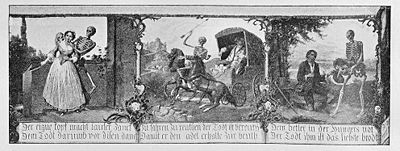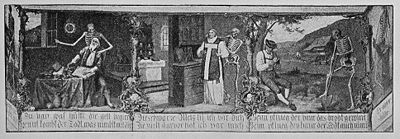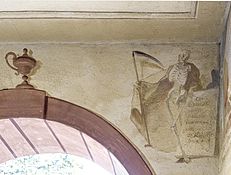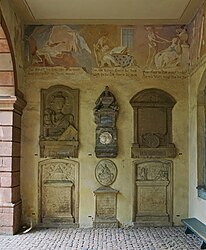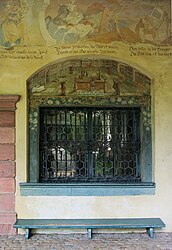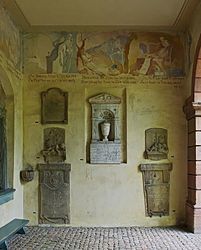Freiburg dance of death
The Freiburg dance of death is the name given to two representations of sequences of the dance of death in the city of Freiburg im Breisgau . One was for a short time in the Freiburg City Hall, the other still exists today in the St. Michaels Chapel in the Old Cemetery in Freiburg.
history
The first series of pictures was painted by the painter Galienus Entringer († 1579) on the front side of the Freiburg town hall, which was built between 1557 and 1559 using existing buildings . However, by order of the council, it had to be replaced again in 1560 by pictures from the life story of King Philip of Macedonia .
The second representation is a cycle of twelve pictures in the vestibule of the Michaelskapelle in the old cemetery in Freiburg directly under the ceiling. The dance of death in the chapel probably originated in the second half of the 18th century. It shows how quickly death can overtake you, regardless of age - shown in pictures 1 to 7 - and the status - shown in pictures 8 to 12. "This is the vestibule for a haunting sermon about the unpredictable end of human life, but at the same time also referred to the help in religion. " These twelve representations are grouped left and right around a picture of the Last Judgment, which is located above the entrance to the chapel.
The chapel and the dance of death were badly damaged in the night of bombing on November 27, 1944 . The version seen today was created in 1963 by the Innsbruck fresco painter Wolfram Köberl . In summer 2012 the vestibule of the chapel with the dance of death was restored; the work was completed on November 4th, 2012.
The original dance of death is attributed to Simon Göser . This original version was restored by Dominik Weber in 1856 and by Sebastian Luz in 1893. In doing so, Luz found that Dominik Weber had not stuck to the original drawing or its coloring. Sebastian Luz removed Weber's treatment as part of the restoration and restored it to its original state. The version by Dominik Weber is recorded in a publication by the Freiburg city archivist Adolf Poinsignon .
In 1887 Dominik Weber painted a dance of death based on the Freiburg model in the Maria Snow Chapel in Herten .
A scene of the dance of death - the death and the pastor - was one of eight oil paintings in the death dance of the soul chapel at the cemetery of Expositurkirche of St. Giles in Zenching taken
Hermann Ginter , from whom the attribution to Göser comes, wrote in summary: “If there weren't other reasons, the whole behavior of death with its opponents would push the name of Göser to the fore. About a dance of death in the usual sense of the word, a struggle between death and life, in which the former performs a dance with man that can be characterized by biting irony, bloody mockery, dark brutality on the one hand and helpless powerlessness on the other nowhere to be mentioned. In all the pictures it is a gentle game full of grace and solemn grace, in which the gaunt skeleton of the dead, despite all the horror of its profession, never forgets to take it with the tact and nobility of the dignified gentleman. In the spirit of early classicism. "
Pictures and texts of the dance of death in the Michaelskapelle in the original version reconstructed by Sebastian Luz in 1893
The pictures come from the book Freiburg im Breisgau. The city and its buildings , 1898. At that time the chapel gable was adorned with a large clock, two boned men - one with a snake, the other with an anchor - and two putti. The whole as a symbol for transience.
Pictures and texts of the dance of death in the Michaelskapelle in the version of Wolfram Köberl from 1963
Left
|
Image 1 Here the child sleeps, there wakes up forever, picture 2 The ABC hardly writes the knab, picture 3 The death takes hold of the head by the hair, |
center
|
Left side
Image 1 The youth are accustomed to fencing, to flushing, picture 2 Death adorns the head with ashes, Which is picture 3 The death alone takes away from Creutz that |
Central picture above the entrance
|
right side
Picture 4 Your own head is loud zanck, Pic 5 The dead are repented to drive to repent, Pic 6 The beggar in need of hunger Death |
Right
|
Image 1 |
Chapel vestibule
The entrance area also includes the two windows of the chapel, which round off the picture band at the top. They are shown here together with the entrance gate to give an impression of the overall appearance. Grave tablets are embedded in the two side walls.
literature
- Adolf Poinsignon : The dance of death in the St. Michaelskapelle in the old cemetery in Freiburg im Breisgau . Freiburg 1891 ( digitized version )
- Friedrich Kempf: The St. Michaels Chapel in the old cemetery . In: Baden Architects and Engineers Association, Upper Rhine District (Ed.): Freiburg im Breisgau. The city and its buildings . HM Poppen & Sohn, Freiburg im Breisgau 1898, p. 382-385 ( Scan - Wikisource ).
- Joachim Faller: For the exterior painting of the St. Michaelskapelle in the Freiburg "Old Cemetery". In: Schau-ins-Land 127, 2008, pp. 47–59 ( digitized version ).
- Wolfgang Hug : The “Freiburg Dance of Death” in the St. Michaelskapelle of the old cemetery . In: Freiburger Diözesan-Archiv 131, 2011, pp. 217-238.
- Hans Georg Wehrens: The dance of death in the Alemannic language area. "I have to do it - and don't know what" . Schnell & Steiner, Regensburg 2012, ISBN 978-3-7954-2563-0 , pp. 247-250.
- Peter Brannath : Seebacher - Death is in the black . Schillinger Verlag, Freiburg 2006, ISBN 978-3-89155-325-1 (detective novel with a close relationship to this dance of death).
Web links
- Hans Sigmund: When death asks you to dance , Badische Zeitung , January 24, 2011.
Individual evidence
- ↑ From a council protocol "The painting at the town hall, of the dead, again to thundt away and instead of the same the histori of King Philippi Macedonie ze molen ...", Hans Rott : Sources and researches on Southwest German and Swiss art history in the XV. and XVI. Century . Volume 3, 1. Stuttgart 1936, p. 112 ( digitized version )
- ↑ See Joachim Faller: On the exterior painting of the St. Michaelskapelle on the Freiburg "Old Cemetery". In: Schau-ins-Land 127, 2008, p. 52.
- ↑ [1] .
- ↑ Hans Georg Wehrens: The dance of death in the Alemannic language area. "I have to do it - and don't know what" . Schnell & Steiner, Regensburg 2012, ISBN 978-3-7954-2563-0 , pp. 247-250.
- ↑ hasi: New Dance of Death , Badische Zeitung on November 2 2012th
- ^ Freiburg im Breisgau. The city and its buildings . Freiburg 1898, pp. 382-385 ( digitized version ).
- ^ Adolf Poinsignon: The dance of death in the St. Michaelskapelle in the old cemetery in Freiburg im Breisgau . Freiburg 1891.
- ↑ In the direction of paradise. About death in the picture. Exhibition, October 24 to December 12, 2008, Museum Obermünster, Emmeramsplatz 1, Regensburg (= art collections of the Diocese of Regensburg, Diocesan Museum of Regensburg, catalogs and publications, Volume 35). Regensburg 2008, p.?.
- ^ Hermann Ginter: Southwest German Church Painting of the Baroque. Dr. Benno Filser Verlag, Augsburg 1929, p. 125.
Coordinates: 48 ° 0 '2.7 " N , 7 ° 51" 25.1 " E




